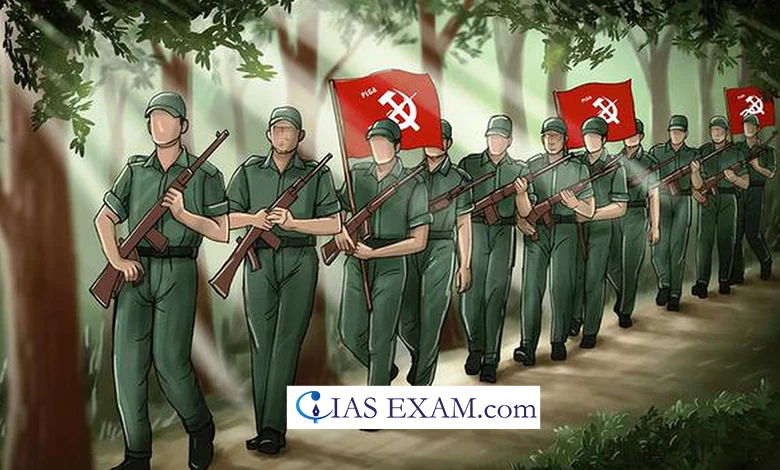
Recent News
Security forces conducted an operation along the Kanker-Narayanpur border in Chhattisgarh’s Bastar region on April 16, resulting in the deaths of at least 29 Maoists.
Details on the Operation and its Impact
In a significant anti-Naxal operation in Chhattisgarh’s Kanker district, security forces reported the elimination of 29 Maoists, including key commanders and several women cadres. The operation, which took place on April 16, 2024, is considered one of the largest and most impactful in recent times, particularly in the Bastar region, known for its Naxal activities. Here are the comprehensive details:
Impact on Maoist Activities
- This encounter has dealt a significant blow to the Maoist groups operating in the region.
- The North Bastar Division, known for collecting illegal levies and providing safe havens to Maoists, has suffered a major setback.
- The operation has disrupted their plans to carry out violent activities during the upcoming Lok Sabha elections.
Ongoing Operations
- The interrogation effort goes on and the authorities are certain that the number of casualties and arrests would only continue to increase.
- The forests with the dense types of vegetation create problems, but the members of the security forces are strongly determined to clear out the area of the presence of the Maoists.
Maoists in India
The Maoist Movement in India otherwise known as the Naxalite Movement is a persistent struggle between Maoist groups, (communist elements) sympathisers of Maoist political orientation and ideology, and the Indian Government. The conflict is rooted in the Naxalbari uprising of 1967 and has since evolved into a complex insurgency with the following key aspects:
- Red Corridor: Strangely enough these regions that are on the “Red Corridor” include about Maoist-affected areas from Chhattisgarh to Jharkhand, Orissa,Andhra, and West Bengal states.
- Impact: Insurgency has incurred great losses in terms of enormous numbers of deaths and damaged property over the years and aftermaths have been seen among Security forces, Maoists and civilians.
- Government Response: To tackle Maoist performance the Indian government resorts to a wide range of tactics such as military operations, projecting infrastructure in underdeveloped regions, and efforts aimed at negotiations with rebels.
- Current Status: In addition to the problems of the small geographical coverage area and a relatively minor number of armed conflicts which made the insurgency popular over the years, the central government is still struggling with it. As the latest reports come in, the “Red Corridor” enters only a few districts, though the impacting zones face Maoist activities.
Reason of Maoists
- Socio-economic Disparities: Widespread poverty, inequitable distribution of resources, and lack of development in rural areas create fertile ground for Maoist recruitment.
- Land Disputes: Displacement of indigenous communities due to industrial projects, land acquisition for infrastructure development, and forest conservation policies have led to grievances and fuelled Maoist movements.
- Exploitation of Tribals: Maoists exploit the marginalised tribal populations, promising them justice and empowerment against perceived exploitation by the state and corporations.
- Government Policies: Maoists oppose government policies and actions they view as oppressive or detrimental to the interests of the marginalised communities, such as forced evictions, mining projects, and forest conservation laws.
- Political Marginalisation: Political marginalisation of certain communities and regions creates a sense of alienation and disillusionment, driving some towards Maoist ideology.
Maoists pose a significant challenge for the country
- Threat to National Security: Maoist associates of the overthrowing ruling pro-democracy authority through violent augmentation. By virtue of aiding and abetting the chaos within the country, they subvert state stability and integrity.
- Violence and Instability: Maoists’ rebel movement results in violence, disorder and destabilisation in affected regions, making people unable to live a normal life, to conduct economic activities, and to take part in developmental initiatives.
- Humanitarian Crisis: Maoist violence causes death, the dropping of population from their homes, and violation of fundamental rights resulting in a humanitarian crisis in the affected regions.
- Economic Impact: Maoist activities lead to investment worrying, disrupt infrastructure construction, and block the economic development, therefore, poverty and underdevelopment will be aggravated in the areas whose suffering.
Conclusion
The presence of Maoists in India represents a significant challenge to the nation’s security, stability, and development. Their aim to overthrow the government through armed struggle, coupled with their violent tactics and control over certain regions, undermines the integrity of the state and disrupts normal life for millions of people. The Maoist insurgency leads to loss of lives, displacement of populations, violations of human rights, and impediments to economic growth and governance.
Source: The Hindu
UPSC Mains Practice Question
Q.Evaluate the impact of Maoist insurgency in India on national security, socio-economic development, and governance. Discuss the effectiveness of government responses and propose strategies to address the root causes of Maoist extremism for lasting peace and stability.





.png)



